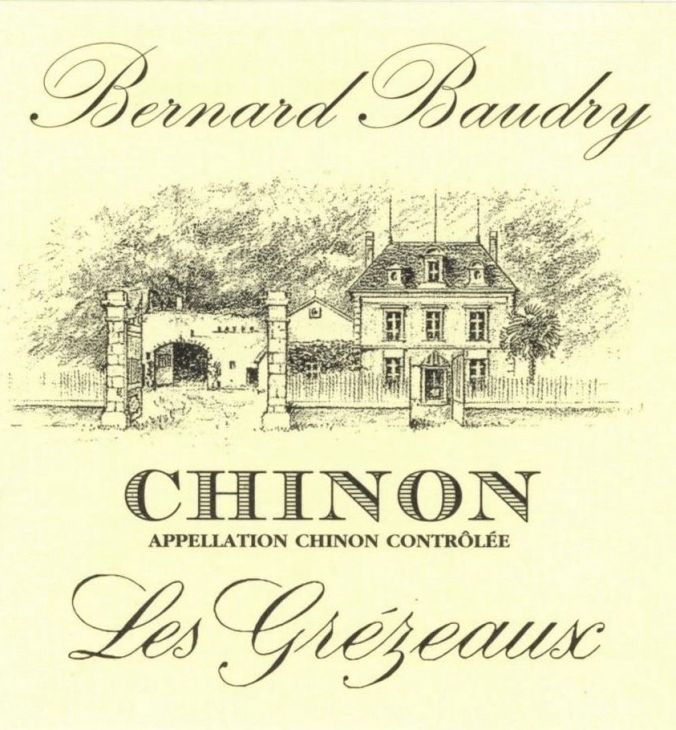
producer profile
31.05.2019
Domaine Bernard Baudry Producer Profile
<p>Bernard Baudry founded his eponymous <glossary title="427">estate</glossary> in the early 1980's with a couple inherited <span class="zalup"><span><glossary title="523">hectares</glossary><span>.</span></span></span> After graduating from the Lycée de <span class="zalup"><span><glossary term="Beaune" title="154">Beaune</glossary><span>,</span></span></span> he quickly rose to prominence in the <glossary title="113">appellation</glossary> for precise, textured<span class="zalup"><span> <glossary title="288">Chinon</glossary><span>.</span></span></span> Today, Bernard is technically retired (<glossary title="1089">vignerons</glossary> never really retire) and his son Matthieu, who has been making wine with his father since 2000, has taken over as head <span class="zalup"><span><glossary title="1089">vigneron</glossary><span>.</span></span></span> </p>
<p>Over the years, the father and son team's fascination with <glossary title="288">Chinon's</glossary> diverse <glossary title="1026">terroirs</glossary> have led them to expand the <glossary title="427">estate</glossary> to its current 32 <span class="zalup"><span> <glossary title="523">hectares</glossary><span>.</span></span></span> The first release and most youthful wine is "Les Granges". This is from <glossary title="1130">young vines</glossary> (25 years old) planted on <glossary title="93">alluvial</glossary> soil and <glossary title="504">gravel</glossary> near the <span class="zalup"><span><glossary term="Vienne River" title="1395">Vienne riverbed</glossary><span>.</span></span></span> When it floods in some springs, Baudry may be found <glossary title="834">pruning</glossary> the vines from a boat. This is a wine that is supple and fruity with smoky cherry fruit and is meant to drink young. It is a perfect wine for simple foods and cheeses.</p>
<p>The "Cuvée Domaine" is a <glossary title="168">blend</glossary> of <glossary title="760">parcels</glossary> of older vines (30-35 years old) planted in <glossary title="93">alluvial</glossary> <glossary title="504">gravel</glossary> bed and hillside<span class="zalup"><span> <glossary title="301">clay</glossary><span>.</span></span></span> It has more <glossary term="Structure" title="990">structure</glossary> and can use a short <glossary term="Aging" title="74">aging</glossary> period in bottle before drinking. The wine has deep, dark ruby color and is beautifully <span class="zalup"><span><glossary term="Extraction" title="433">extracted</glossary><span>.</span></span></span></p>
<p>"Les Grézeaux"<em> </em>is from vines of 40 years on average, planted on <glossary title="504">gravely</glossary> soil with a bedrock of <glossary title="596">limestone</glossary> and <span class="zalup"><span><glossary title="301">clay</glossary><span>.</span></span></span> For many years it was <glossary title="74">aged</glossary> in <glossary term="Barrique" title="144">barrique</glossary> but today it is only <glossary title="441">fermented</glossary> and <glossary title="74">aged</glossary> in large <span class="zalup"><span><glossary title="325">concrete vats</glossary><span>.</span></span></span> </p>
<p>"Clos Guillot" is a four <glossary title="523">hectare</glossary> <glossary title="1133">plot</glossary> of vines Bernard replanted in 1995 on a site abandoned since World War 2. It <glossary title="441">ferments</glossary> in <glossary title="325">concrete</glossary> and is <glossary title="74">aged</glossary> in <span class="zalup"><span><glossary title="142">barrel</glossary><span>.</span></span></span> </p>
<p>Finally, "Croix Boisée" comes from the Baudry's "<glossary title="501">Grand Cru</glossary>" vineyards, two <glossary title="523">hectares</glossary> <glossary title="430">exposed</glossary> full south on <glossary title="301">clay</glossary> and <span class="zalup"><span><glossary title="596">limestone</glossary><span>.</span></span></span> <glossary title="281">Chenin Blanc</glossary> and <glossary title="216">Cabernet Franc</glossary> is planted here and two separate wines are producee under the "Croix Boisée" label. These are are a much more <glossary term="Structure" title="990">structured</glossary> affair, hence their <glossary title="441">fermentation</glossary> and <glossary title="74">aging</glossary> in <span class="zalup"><span><glossary title="142">barrel</glossary><span>.</span></span></span> </p>
<p>A small amount of <glossary title="288">Chinon</glossary> Blanc and <glossary title="871">rosé</glossary> is also produced; both have a cult following and sell out instantly. </p>
Article
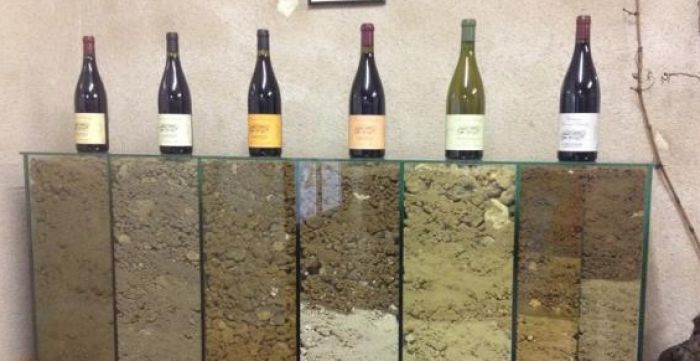
producer visit
17.07.2019
This visit to Domaine Bernard Baudry took place in February, 2013
<p><strong><em>This visit to Domaine Bernard Baudry took place in February, 2013.</em></strong></p>
<p><strong><em>Words by Jules Dressner, photos by Susie Curnutte and Bonnie Crocker.</em></strong></p>
<p>Because it had been raining on and off all day, our vineyard time was limited. We started by visiting Les Granges, the <glossary title="594">lieu-dit</glossary> which produces the Baudry's entry level <span class="zalup"><span><glossary title="363">cuvée</glossary><span>.</span></span></span></p>
<p><img src="http://louisdressner.com/uploads/images/article/2019_Jul_17//d3/dd/d3dd70a1eb09aae9d8ef833949a3c915.jpg" /></p>
<p><img src="http://louisdressner.com/uploads/images/article/2019_Jul_17//82/a6/82a602d492f96767ebc70ad87dcf021b.jpg" /></p>
<p><img src="http://louisdressner.com/uploads/images/article/2019_Jul_17//ef/89/ef894bd82b16c431b90877e9c5e4fba5.jpg" /></p>
<p>Located on the right bank of <span class="zalup"><span><glossary title="288">Chinon</glossary><span>,</span></span></span> the Baudry own eight <glossary title="523">hectares</glossary> of land here. The vines are around 25 years old. The soils are <glossary title="909">sand</glossary> and <glossary title="504">gravel</glossary> and <glossary title="1129">yields</glossary> average 45<glossary term="hl/ha" title="528">hl/ha</glossary><span class="zalup"><span><span>.</span></span></span> The entire <glossary title="427">estate</glossary> has been <glossary title="260">certified organic</glossary> since 2006. Bernard has always worked the soil and used <span class="zalup"><span><glossary title="538">native yeasts</glossary><span>.</span></span></span> <br />
<br />
On these vineyards, Matthieu and Bernard feel the need to use homemade<span class="zalup"><span> <glossary title="323">compost</glossary><span>,</span></span></span> as the soils are very poor: not nourishing them would significantly lower <span class="zalup"><span><glossary title="1129">yields</glossary><span>.</span></span></span> While many growers intentionally seek lower <glossary title="1129">yields</glossary> in order to obtain higher <glossary title="324">concentration</glossary> in their grapes, in the case of Les Granges the Baudrys feel that lower <glossary title="1129">yields</glossary> lead to harsh, undesirable <span class="zalup"><span><glossary title="1010">tannins</glossary><span>.</span></span></span> They also perform a superficial work of the soil to rid it of competing grass.<br />
<br />
<em>"Working the soil is very important to bring out<span class="zalup"><span> <glossary title="662"><em>minerality</em></glossary><span>,</span></span></span> even in lesser <span class="zalup"><span><glossary title="1026"><em>terroirs</em></glossary><span>.</span></span></span> </em><glossary title="216"><em>Cabernet Franc</em></glossary><em> can be planted anywhere. Good wine tastes like<span class="zalup"><span> <glossary title="1026"><em>terroir</em></glossary><span>.</span></span></span>"</em></p>
<p><img src="http://louisdressner.com/uploads/images/article/2019_Jul_17//68/e4/68e4468e19f70a62dfdacb6f998ee953.jpg" /></p>
<p>That, my friends, is a man who looks like he knows what he's talking about. <br />
<br />
Many of the hillsides surrounding the area are forested. These used to be widely planted in vineyards, but have not been replanted since the end of World War 2. Matthieu explained that many of these sites had been destroyed during combat, and that when it was time to replant, many favored the more fertile, easier to work plains, as well as faster growing crops such as corn and cereals.<br />
<br />
After checking out Les Granges, we drove over to the enigmatic Croix Boisée site. On our way over, Matthieu pointed out the aforementioned homemade <span class="zalup"><span><glossary term="Compost" title="323">compost</glossary><span>.</span></span></span> <br />
<br />
<img src="http://louisdressner.com/uploads/images/article/2019_Jul_17//7f/01/7f01f3b99650dc3426e0d7bf03c06755.jpg" /></p>
<p>That's a hefty heap of <span class="zalup"><span><glossary title="323">compost</glossary><span>!</span></span></span> A few minutes later we were at the Croix Boisée, which is located on the top of a pretty hill.</p>
<p><img src="http://louisdressner.com/uploads/images/article/2019_Jul_17//5d/5a/5d5a2112a0650a4f0e286295fcaad89b.jpg" /></p>
<p><img src="http://louisdressner.com/uploads/images/article/2019_Jul_17//9e/e6/9ee68c07fdf3c0b2cc4b28045c51901c.jpg" /></p>
<p>Okay, so there is a lot going on in this two <glossary title="523">hectare</glossary> <span class="zalup"><span><glossary title="760">parcel</glossary><span>.</span></span></span></p>
<p><img src="http://louisdressner.com/uploads/images/article/2019_Jul_17//bb/16/bb16d862acc2b61b168551fac3f977f7.jpg" /></p>
<p><img src="http://louisdressner.com/uploads/images/article/2019_Jul_17//a1/09/a10908f6be3ed5c1d659ef098ab5d601.jpg" /></p>
<p><img src="http://louisdressner.com/uploads/images/article/2019_Jul_17//a7/30/a7304ff991796aa9dd0b2d8f618b7aec.jpg" /></p>
<p><glossary title="288">Chinon</glossary> is very similar to <glossary title="212">Burgundy</glossary> in that the richness of the soils vary on the top, middle and the bottom of the hill. On the top of the vineyard, Matthieu showed us a bank where you could easily see the <glossary title="266">chalky</glossary> <glossary title="596">limestone</glossary> that dominates the top half.</p>
<p><img src="http://louisdressner.com/uploads/images/article/2019_Jul_17//a4/8b/a48be05e3e894ee5afcbdece32994d53.jpg" /><br />
<br />
The top of the hill is the richest in <span class="zalup"><span><glossary title="596">limestone</glossary><span>,</span></span></span> which is less favorable for <glossary title="216">Cabernet Franc</glossary> and really good for <span class="zalup"><span><glossary title="281">Chenin</glossary><span>.</span></span></span> So they planted some, and this produces the "Croix Boisée Blanc".</p>
<p>Walking down the rows, it is easy to spot how the <glossary title="596">limestone</glossary> becomes less and less prominent. </p>
<p><img src="http://louisdressner.com/uploads/images/article/2019_Jul_17//a8/35/a835a76d44176ae5fea85c0c5bf10603.jpg" /></p>
<p><img src="http://louisdressner.com/uploads/images/article/2019_Jul_17//05/e9/05e91b7208975e3f496e0b77db3a7258.jpg" /></p>
<p><img src="http://louisdressner.com/uploads/images/article/2019_Jul_17//64/ad/64adb6422bf7718d88dbd6664f8ece74.jpg" /><br />
<br />
The middle becomes heavier in <span class="zalup"><span><glossary title="301">clay</glossary><span>,</span></span></span> while the bottom of the hill is a mix of <glossary title="301">clay</glossary> and <glossary title="909">sand </glossary>that <em>"brings ripeness"</em>. <br />
<br />
After visiting the vines, we drove back to the <span class="zalup"><span><glossary title="427">estate</glossary><span>.</span></span></span> As of 2005, the vast majority of the Baudry wines are <glossary title="441">fermented</glossary> in large <span class="zalup"><span><glossary title="325">concrete tanks</glossary><span>.</span></span></span> "Les Granges"<em>, </em>"Cuvée Domaine"<em> </em>and<em> "</em>Les Grézaux<em>"</em> are <glossary title="441">fermented</glossary> and <glossary title="74">aged</glossary> in<span class="zalup"><span> <glossary title="325">concrete</glossary><span>,</span></span></span> "Clos Guillot" is <glossary title="441">fermented</glossary> in <glossary title="325">concrete</glossary> and <glossary title="74">aged</glossary> in <glossary title="142">barrel</glossary> a year and "Croix Boisée" is <glossary title="441">fermented</glossary> and <glossary title="74">aged</glossary> in <span class="zalup"><span><glossary title="142">barrel</glossary><span>.</span></span></span> Matthieu explained that <glossary title="325">concrete</glossary> gives them the ability to let the wine spend extended time in the same vessel, avoiding the need for constant <span class="zalup"><span><glossary title="843">rackings</glossary><span>,</span></span></span> <glossary title="993">sulfuring</glossary> and manipulation. <br />
<br />
<em>"When you don't add </em><glossary title="1128"><em>yeasts</em></glossary><em> or <span class="zalup"><span><glossary title="447"><em>filter</em></glossary><span>,</span></span></span> you need to </em><glossary title="185"><em>bottle</em></glossary><em> as late as possible."</em><br />
<br />
We then walked over to the <glossary title="74">aging</glossary> <span class="zalup"><span><glossary title="254">cellar</glossary><span>,</span></span></span> a beautiful <glossary term="Cave" title="251">cave</glossary> carved in <span class="zalup"><span><glossary title="1053">tuffeau limestone</glossary><span>.</span></span></span> <br />
<br />
<img src="http://louisdressner.com/uploads/images/article/2019_Jul_17//16/27/16277d82ee049aa29fc4a52cbe3beb45.jpg" /></p>
<p><img src="http://louisdressner.com/uploads/images/article/2019_Jul_17//f5/ce/f5ce764f3b0fd2d45ef4bab9b0041e3d.jpg" /></p>
<p><img src="http://louisdressner.com/uploads/images/article/2019_Jul_17//4b/02/4b024724a3882d626b950e6d39f63f5e.jpg" /><br />
<br />
Much to my surprise, we ended up tasting all of the 2012's. The "Croix Boisée" was still very young and green, I couldn't believe how well the wines were showing at such an early stage. Matthieu shared my sentiments, explaining that they are usually in a much tougher place at this point of the year.</p>
<p>The 2012 <glossary title="871">rosé</glossary> had finished <glossary title="441">fermenting</glossary> but was still gassy. This one will be available soon and will not disappoint. <br />
<br />
We ended the visit in the Baudry's tasting room. The big attraction was the famed "<glossary title="1026">Terroir</glossary> Display". <br />
<br />
<img src="http://louisdressner.com/uploads/images/article/2019_Jul_17//36/bb/36bbef4fd85271070d354c2d8cbb16a2.jpg" /><br />
<br />
A true labor of love, Matthieu and Bernard dug into their <glossary title="991">subsoils</glossary> and reconstituted them into glass containers so their customers could see exactly what was going on down there. Not too shabby...<br />
<br />
We then re-tasted the 2011's and 2010's, (they're great) drank a 1999 "Croix Boisée", 2003 "Franc de Pied" and had a typically <glossary term="Loire Valley" title="602">Loire</glossary> lunch, which was 96% pork.</p>
Article
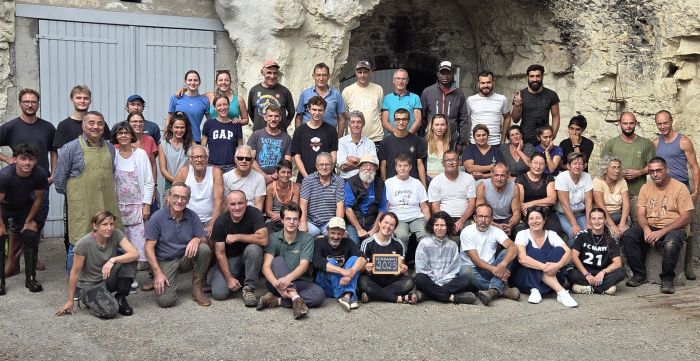
harvest report
30.12.2025
2025 Harvest Report from Matthieu Baudry
<p>2025 feels like the polar opposite of its neighbor 2024. The dry climate we saw is in fact more reminiscent of nice years like 2020 and 2022. </p>
<p>Winter was rainy up until mid-March, followed by nice weather without any extreme spikes, leading to a healthy spring void of illness; only four treatments were applied the entire season which is pretty exceptional. </p>
<p>Flowering was early and followed by a dry and hot summer punctuated by good, necessary rains in July. But then August was very dry, seriously accelerating the grapes' maturities. We were worried the vines would suffer from hydric stress in the sandy sectors; while this was a legitimate concern it only ended up lowering yields in these areas a tiny bit. We did get some rain at the end of August, but it didn't do much to change our very precocious harvest date.</p>
<p>We started with some Chenin at the very end of August for our yet to be released sparkling wine, then early September for the dry whites. The Cabernet Franc was just as early-ripening as 2022. The wines are concentrated and reminiscent of GOOD hot years like 2018, 2020 and 2022 yet with their own, very interesting balance. And despite their relatively low acidity, the 2025 are still very juicy and salivating. </p>
<p>We're also happy to announce that 2025 will see the return of "Croix Boissée Blanc" which had not been produced in the last few vintages.</p>
<p><img src="https://louisdressner.com/uploads/images/article//1088/22/0d/220d902fd0542fead83e4de68d6133bc.jpg" /><img src="https://louisdressner.com/uploads/images/article//1088/49/71/49719572fc7eb672782db2e18867e5fe.jpg" /><img src="https://louisdressner.com/uploads/images/article//1088/5e/9e/5e9e3f84e27601dbd77a3cdba99aac34.jpg" /></p>
Article

harvest report
04.12.2024
2024 Harvest Report from Matthieu Baudry
<p>2024 was marked by a record amount of rainfall in France and Chinon was not spared. After avoiding any issues with frost, we were under intense mildew pressure from early May through mid-August. We spent all Spring and Summer fighting against this illness, which gnawed at the leaves and many grapes in certain parcels. </p>
<p>We were hoping for an Indian summer that never came: September was just as rainy and forced us to push back our harvest start date to October. We then hoped that this extra time would give the grapes more time to concentrate in sugars but this remained fairly limited. </p>
<p>Despite the weather conditions, the Cabernet Franc resisted fairly well but mildew still severely reduced our crop to about 30hl/h. With the Chenin, itself a thin-skinned variety, we had to find very short windows to pick so that the grapes not be diluted from water. </p>
<p>The 2024 reds have nice color and structure, clocking in between 11.5 and 12.5 and without any agressive green notes. It's a little early to tell, but 2024 seems very promising and already superior to 2023, another vintage marked by heavy rain. </p>
Article
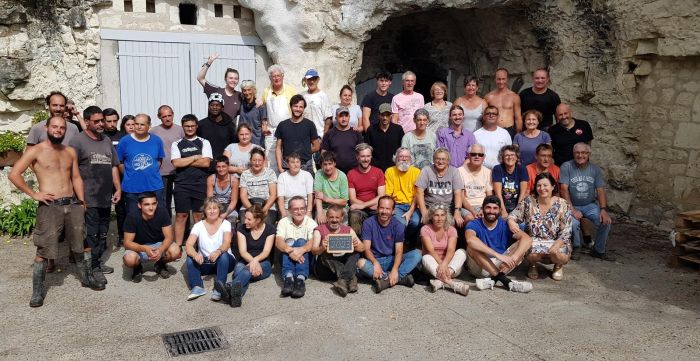
harvest report
04.01.2023
2023 Harvest Report from Matthieu Baudry
<p><strong>November 16th, 2023:</strong></p>
<p>Tropical!</p>
<p>We will always remember 2023 as a year of constant heat and humidity with vines that never ceased growing, even during the <span class="zalup"><span><glossary term="Harvest" title="521">harvest</glossary><span>.</span></span></span> We had to be in the vines constantly to treat against <glossary term="Mildew" title="1137">mildew</glossary> and never got a break. The entire team remained in a constant state of mobilization. The result was satisfying, even very satisfying, notably for the <glossary term="Cabernet Franc" title="216">Cabernets</glossary> that really pulled through with high <glossary term="Yield" title="1129">yields</glossary> for the reds and rosé. </p>
<p>We were however disappointed with the <span class="zalup"><span><glossary term="Chenin Blanc" title="281">Chenins</glossary><span>,</span></span></span> which were not able to ripen in as ideal conditions. Unfortunately, <glossary term="Chenin Blanc" title="281">Chenin</glossary>'s fine and fragile skins didn't really appreciate the weather conditions, and we had to do a lot of <glossary term="Sorting" title="1380">sorting</glossary> in the vines to pick <glossary term="Cluster/Bunch" title="1138">bunches</glossary> that remained healthy but with noticeably less sugar than we are used to.</p>
<p>The result? The red <glossary term="Chinon" title="288">Chinons</glossary> are looking to be generous and juicy, bursting with fruit and with a <glossary term="Tannin" title="1010">tannic structure</glossary> less rich than 2020 or 2022. The rosé should make fans of fresh, easy drinking Spring releases very happy, as it clocks in at 12% and is already drinking very well. </p>
<p>Like in 2021 and 2022, only one white will be released, the "Domaine Blanc". It is light in matter but shows nice, crunchy fruit. We've also made our first sparkling wine, which we intend to release after two to three years <span class="zalup"><span><glossary term="Sur Lattes" title="995">sur lattes</glossary><span>.</span></span></span> Let's see!</p>
<p><img src="https://louisdressner.com/uploads/images/article//1005/02/37/0237095793916bc18afc73cbfc315608.jpg" /><img src="https://louisdressner.com/uploads/images/article//1005/5e/c5/5ec545bd37e7ba6e11d64c713441749b.jpg" /><img src="https://louisdressner.com/uploads/images/article//1005/b7/4e/b74efe2928414295810f71ca653286f9.jpg" /><img src="https://louisdressner.com/uploads/images/article//1005/66/1c/661c918db7fc86378b6eb533f2cde3ca.jpg" /><img src="https://louisdressner.com/uploads/images/article//1005/17/21/1721297a6f164544a2eed206365c0958.jpg" /><img src="https://louisdressner.com/uploads/images/article//1005/ab/7a/ab7ac527e4bc982d7467cb652f56919d.jpg" /><img src="https://louisdressner.com/uploads/images/article//1005/91/2b/912b6149bafaa970f2114343cf1f9804.jpg" /></p>
Article
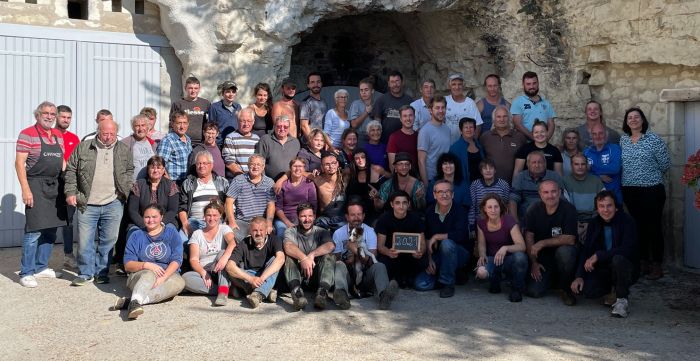
harvest report
08.12.2021
2021 Harvest Report from Matthieu Baudry
<p>We ended our 2021 <glossary term="Harvest" title="521">harvest</glossary> on October 9th over beautiful weather, the last thing we'd expect after a year of so many climactic calamities. What an adventure 2021 has been! Mother nature kept us busy year round with next to no downtime. I'd go as far as saying it was the most labor intensive year we've ever known at the <span class="zalup"><span><glossary term="Estate" title="427">estate</glossary><span>.</span></span></span> </p>
<p>I'll start to say that we are very satisfied with the <glossary term="Cabernet Franc" title="216">Cabernets</glossary> because they hadn't been too affected by the <glossary term="Frost" title="1135">frost</glossary> and actually gave us a generous <span class="zalup"><span><glossary term="Harvest" title="521">harvest</glossary><span>.</span></span></span> We tirelessly and successfully fought off <glossary term="Mildew" title="1137">mildew</glossary> and the grapes took advantage of the late summer's rainfall followed by good sun in September and October. For the <glossary term="Chenin Blanc" title="281">Chenin</glossary> we are disappointed, we lost about 30% despite the foliage not succumbing to <span class="zalup"><span><glossary term="Mildew" title="1137">mildew</glossary><span>.</span></span></span> <glossary term="Chenin Blanc" title="281">Chenin</glossary> is much more sensitive than <glossary term="Cabernet Franc" title="216">Cabernet</glossary> to <glossary term="Frost" title="1135">frost</glossary> and even the vines planted on <glossary term="Coteau" title="345">coteaux</glossary> were affected. </p>
<p>Next we have to start thinking of the quality of the <span class="zalup"><span><glossary term="Vintage" title="1109">vintage</glossary><span>.</span></span></span> It's of course too early to know for sure based on the year's extreme climate. The grapes we picked were in good shape with no <glossary term="Mildew" title="1137">mildew</glossary> or <span class="zalup"><span><glossary term="Botrytis/Noble Rot" title="181">botrytis</glossary><span>.</span></span></span> The berries were solid, with good, balanced sugar resulting in more energetic <glossary term="Fermentation" title="441">fermentations</glossary> than some of the recent rich <glossary term="Vintage" title="1109">vintages</glossary> we've seen (2017, 2018, 2019). We're now halfway through <glossary term="Racking/Soutirage" title="843">racking</glossary> the <glossary term="Free-Run Juice" title="468">free run juice</glossary> and the wines seem subtle and fruity with nice color. It's hard to compare to other <glossary term="Vintage" title="1109">vintages</glossary> but it's definitely going to stand out from rich wines we've been producing the last few years. </p>
<p>Finally, I'd like to thank my full time team as well as the seasonal workers who did remarkable work in the vines and who were always ready and motivated to fight against <glossary term="Frost" title="1135">frost</glossary> and <span class="zalup"><span><glossary term="Mildew" title="1137">mildew</glossary><span>,</span></span></span> it was a lot of long days and nights. Without them the harvest would not have the same quantity, quality and taste. Cheers!</p>
<p>Matthieu,</p>
<p><img src="https://louisdressner.com/uploads/images/article//899/87/58/875881e002985497355bfbf30acd517d.jpg" /><img src="https://louisdressner.com/uploads/images/article//899/44/cb/44cbb055cb919fb7168741e9f196976f.jpg" /><img src="https://louisdressner.com/uploads/images/article//899/58/fb/58fbc0562f56f63fb4aedac3fb3d1613.jpg" /><img src="https://louisdressner.com/uploads/images/article//899/44/55/4455a80ae44a2e340b761265eedf1eee.jpg" /><img src="https://louisdressner.com/uploads/images/article//899/8b/0e/8b0e4156a796d87080c103260a44a411.jpg" /><img src="https://louisdressner.com/uploads/images/article//899/b9/34/b934e7ebd569f6a04ba71c4b25312981.jpg" /><img src="https://louisdressner.com/uploads/images/article//899/85/53/85532a07e6aace3f73726a9ea99450db.jpg" /><img src="https://louisdressner.com/uploads/images/article//899/b8/10/b8101c71af079c1778908b440845b8ad.jpg" /><img src="https://louisdressner.com/uploads/images/article//899/98/fc/98fc61b32e643b880902f980649f2012.jpg" /><img src="https://louisdressner.com/uploads/images/article//899/57/fa/57faa4e3482be2452bef9f133fa8f856.jpg" /><img src="https://louisdressner.com/uploads/images/article//899/96/76/9676c258cde743f8415acc061e852a0d.jpg" /></p>
Article
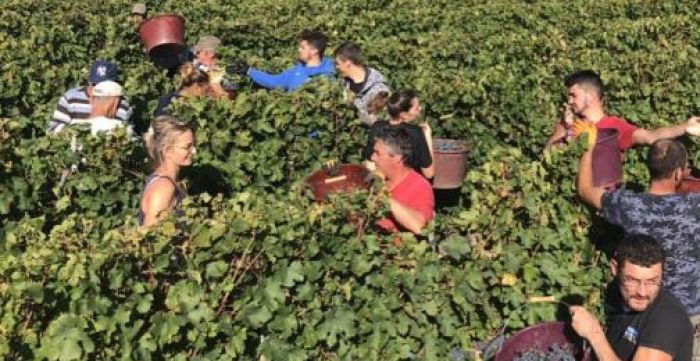
harvest report
14.10.2018
2018 Harvest Report from Matthieu Baudry
<p>In 2018, winter and spring were rather mild, with much needed rain restocking our dry, deficient <glossary term="Subsoil" title="991">subsoils</glossary> from last year. We were also spared the <glossary title="1135">frost</glossary> that impacted us greatly in the last two <span class="zalup"><span><glossary title="1109">vintages</glossary><span>.</span></span></span><br />
<br />
It was quite a reversal in late May to early July: tropical weather. <glossary title="1179">Flowering</glossary> was once again very precocious like in 2017, with a nice charge of future <span class="zalup"><span><glossary title="1138">clusters</glossary><span>.</span></span></span> We worked vigorously and non-stop to combat <glossary title="1137">mildew</glossary>; in the end the illness still took out a good amount of our <glossary title="206">buds</glossary> before they'd fully formed.<br />
<br />
The rest of the summer was very warm and terribly dry. We only got 40mm of rain between July 20th and mid-September. The vines continued feeding the grapes but some nonetheless suffered from the <span class="zalup"><span><glossary title="1167">drought</glossary><span>,</span></span></span> most notably in the <glossary title="93">alluvial</glossary> soils.</p>
<p><img src="http://louisdressner.com/uploads/images/article/2020_Jul_14//0f/94/0f9417fe26708725ea8bf29a676cff5a.jpg" /></p>
<p>It was another year of very early harvesting: we started with <glossary title="281">Chenin</glossary> on September 12th and the first <glossary title="216">Cabernets</glossary> around the 18th. The richness of the sugars is exceptional, with <glossary term="alcoholic potential" title="1381">potentials</glossary> between 13 and 14.5% paired with good <span class="zalup"><span><glossary term="Tartaric Acid" title="1012">tartaric acids</glossary><span>.</span></span></span> 2018 is an incredibly complete and expressive <span class="zalup"><span><glossary term="Vintage" title="1109">vintage</glossary><span>,</span></span></span> I'd wager it even better than the legendary years of 2005 and 2010.<br />
<br />
The amount many of us produced will also be a breath of oxygen for the many <glossary term="Vigneron/Vignaiolo" title="1089">vignerons</glossary> who've suffered so greatly in 2016 and 2017. In any case, something has become evident and imposed: in the last 30 years (1988-2018), temperatures have risen by over one degree in the period of March and September. The result is that the grapes have gained 3% of alcohol and <glossary term="Acidity" title="71">acidities</glossary> have gone down to an average of 4g/L.<br />
<br />
For us, global warming is evident: we are harvesting earlier and earlier (one to two weeks) and are regularly <glossary title="1104">vinifying</glossary> <glossary title="216">Cabernet Franc</glossary> that clocks in above 13%. While I feel it's a positive evolution for the beauty and expression of <glossary title="216">Cabernet Franc</glossary> in the <span class="zalup"><span><glossary title="602">Loire</glossary><span>,</span></span></span> it's much more preoccupying and worrisome for our planet...</p>
<p><img src="http://louisdressner.com/uploads/images/article/2020_Jul_14//a5/06/a506b8bdaf71ac62c7c505965bc5a00a.jpg" /></p>
Article
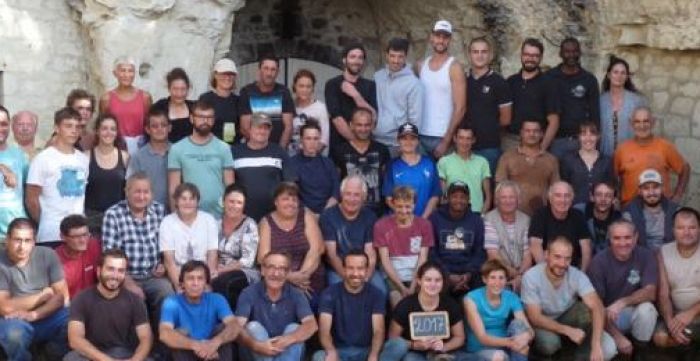
harvest report
14.10.2017
2017 Harvest Report from Matthieu Baudry
<p>All you need to do is look at the happy faces of our team to show the satisfaction of finishing a <glossary term="Harvest" title="521">harvest</glossary> that had started really poorly!<br />
<br />
Let's not forget that yet another threat of <glossary term="Frost" title="1135">frost</glossary> loomed over us for many nights, just as it did in many other regions. For five nights, we fought it will everything we had: candles, anti<span class="zalup"><span><span>-</span><glossary term="Frost" title="1135">frost</glossary> </span></span> towers and spraying hot water to avoid the catastrophe of 2016.<br />
<br />
While these methods were quite successful, it's important to point out that the temperatures never went below -3° C. In the end we were able to escape unscathed from a hellish period. The end of spring was beautiful, with an exceptional May an a precocious <glossary term="Flowering" title="1179">flowering</glossary> in June.<br />
<br />
Summer was a little spottier but the vines got the rain they needed and in the end we started about 15 days earlier than a traditional <span class="zalup"><span><glossary term="Vintage" title="1109">vintage</glossary><span>.</span></span></span> Like the old guard says, a precocious <glossary term="Vintage" title="1109">vintage</glossary> is rarely a bad one in <span class="zalup"><span><glossary term="Chinon" title="288">Chinon</glossary><span>.</span></span></span> 2017 is looking great, with a generous <glossary term="Harvest" title="521">harvest</glossary> of grapes high in sugar and flavor.<br />
<br />
While all the conditions for an excellent <glossary term="Vintage" title="1109">vintage</glossary> have been given to us, it is with a heavy heart that we think of all our colleagues who suffered terribly from the <glossary term="Frost" title="1135">frost</glossary> and other climactic challenges.</p>
Article

harvest report
10.11.2014
2014 Harvest Report from Matthieu Baudry
<p>All hail September!<br />
<br />
Winter was particularly mild, with a lot of rain and temperatures never sinking into the minuses; a rather rare occurrence here despite our moderate climate. Fortunately, the cold didn't decide to show up in spring during the very stressful <glossary title="1166">débourrement</glossary> of the vines. Unlike 2012 and 2013, we suffered from no <glossary title="1135">frost</glossary> this year.<br />
<br />
Spring was also quite mellow, with little rain except for May. This meant fast, homogenous<span class="zalup"><span> <glossary title="1179">flowering</glossary><span>.</span></span></span> Most "clairvoyants" gave us the green light to expect a comfortable <glossary title="521">harvest</glossary> with good quantities and healthy grapes. A very hot June permitted the vines to advance their development and prepare beautiful fruit.<br />
<br />
But then, July and August were drenched. As summer progressed, <glossary title="1137">mildew</glossary> pressure became more and more of a threat, and we were obliged to <glossary title="328">treat</glossary> on an almost weekly basis. An anticyclone never came, meaning constant rains and cool temperatures. By late August, morale was rather low because it was looking like a repeat of the humid 2013 <span class="zalup"><span><glossary term="Vintage" title="1109">vintage</glossary><span>.</span></span></span><br />
<br />
But in the end, a miracle produced itself early September with incredible weather that lasted through the<span class="zalup"><span> <glossary term="Harvest" title="521">harvest</glossary><span>.</span></span></span> In fact, there was almost no rain all month and the sunshine was exceptional. We began harvesting on September 29th in a much better context than 2013, with clean grapes rich in sugar.<br />
<br />
With the <glossary title="441">fermentations</glossary> done, the wines have proven very seductive. They have the richness of 2009 but with better <glossary title="71">acidity</glossary> and more vibrant color. We are extremely satisfied but also relieved after such a mediocre summer and the low volume of the last two <span class="zalup"><span><glossary term="Vintage" title="1109">vintages</glossary><span>.</span></span></span> <glossary title="1129">Yields</glossary> were quite generous, and hovered around 40<glossary title="524">hl</glossary>/ <span class="zalup"><span><glossary title="523">ha</glossary><span>,</span></span></span> the usual we except in a "normal" <span class="zalup"><span><glossary term="Vintage" title="1109">vintage</glossary><span>.</span></span></span><br />
<br />
Thank you September! 2014 should prove to be a very beautiful <span class="zalup"><span><glossary term="Vintage" title="1109">vintage</glossary><span>!</span></span></span></p>
Article
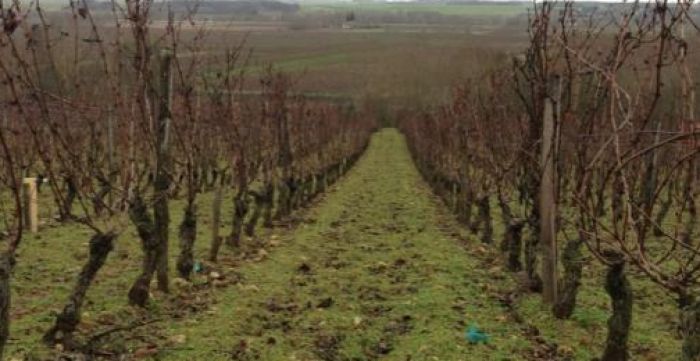
harvest report
03.12.2013
2013 Harvest Report from Matthieu Baudry
<p>You need nerves of steel to not give up when the weather is so unfavorable; this is the burden of the <span class="zalup"><span><glossary term="Vigneron/Vignaiolo" title="1089">vigneron</glossary><span>,</span></span></span> who we sometimes forget are completely "climate-dependant". We were anticipating it, and unfortunately the rain was present from the beginning of the season right up the the eagerly awaited moment of <span class="zalup"><span><glossary term="Harvest" title="521">harvest</glossary><span>.</span></span></span> The work in the vines was laborious, all to ensure the best sanitary state for the grapes in order to have the best <glossary term="Maturation" title="639">maturities</glossary> possible. At times, the team reached a boiling point of frustration. In hindsight, however, this enticed renewed modesty and humility to the fascinating work we do every year.<br />
<br />
After a winter that felt like it was never going to end, the entire spring season was very wet. This delayed the vegetal cycle even more, but in the end the grapes <glossary term="Flowering" title="1179">flowered</glossary> in good conditions. Summer was warmer, but the pressure from illness was strong due to the humidity accumulated over the spring. <glossary term="Contact Treatment" title="328">Treatments</glossary> were rigorous even well into September. And then, the nice weather was once again replaced with rain from mid-september right up until the<span class="zalup"><span> <glossary term="Harvest" title="521">harvest</glossary><span>.</span></span></span><br />
<br />
This was the tardiest <glossary term="Harvest" title="521">harvest</glossary> in the last 30 years, and we really needed to wait for <glossary term="Phenols" title="784">phenolic ripeness</glossary> (principally for <glossary term="Tannin" title="1010">tannins</glossary>). I don't know if we would have taken this type of risk 30 years ago, but today I feel it is absolutely necessary to wait and <glossary term="Harvest" title="521">harvest</glossary> the ripest fruit!<br />
<br />
2013 will be marked by a lack of <glossary term="Concentration" title="324">concentration</glossary> compared to past <span class="zalup"><span><glossary term="Vintage" title="1109">vintages</glossary><span>,</span></span></span> which can entirely be blamed on the rain. Fortunately, the trade off is that they are very fruity and accessible. Fans of rich, <glossary term="Structure" title="990">structured</glossary> wines meant to <glossary term="Aging" title="74">age</glossary> may be frustrated, but those who enjoy light, tender wines meant to be drunk young will be delighted.<br />
<br />
Another direct result of the rain, we've produced some very delicious <glossary term="Rosé/Rosato" title="871">rosé</glossary> which we had de-prioritized in the last few years due favorable circumstances for reds with a lot of character.</p>
Article

harvest report
23.11.2011
2011 Harvest Report from Matthieu Baudry
<p><u><strong>Part 1:</strong></u></p>
<p>Pressure is mounting and we keep a constant eye on the weather forecast: "Dad, the weather's on, quick come see! " Even the kids are getting into it...<br />
<br />
"Around the 13th...Or maybe the 16th..." The pickers keep calling us for our decision and we keep telling them: "When the grapes are ripe." The grapes decide not us... well almost!<br />
<br />
Spring 2011 was the summer, and summer is the spring. The vines have never been so green before <glossary term="Harvest" title="521">harvest</glossary> yet they where turning yellow at the end of June ...<br />
<br />
The grapes held up and withstood the regular rainfall we've had all summer. They have grown quite a bit and we should have very generous <span class="zalup"><span><glossary term="Yield" title="1129">yields</glossary><span>.</span></span></span> The <glossary term="Acidity" title="71">acidity</glossary> is rather low at the moment but levels are rising slowly. Nothing alarming, and we're remaining optimistic. Even the eternally anxious Bernard doesn't seem too worried.<br />
<br />
We've got our fingers crossed and expect a great week of good weather, cool nights and reassuring weather forecasts.<br />
<br />
"Dad! The weather's on!"</p>
<p><u><strong>Part 2:</strong></u></p>
<p>2011 was a crazy year! Summer in spring, fall in the summer and spring in fall… I wonder if our dear planet's poles decided to inverse themselves this year.<br />
<br />
As far as rain goes in 2011, we registered 160mm of water between January 1st and July 15th (a little more than six months), and 170 mm between July 15th and September 15th (2 months)...<br />
<br />
In other words, the grapes took in a lot of water in a short period of time, but this was necessary to rehydrate them. Without that rain, we would have <glossary title="521">harvested</glossary> little peas with no flesh or juice. Still, it would have been nice if the rain had stopped on the 15 first days of September, because we were worried about rot.<br />
<br />
These climactic excesses make us wonder what the future will hold…<br />
<br />
The <glossary title="521">harvest</glossary> took place from the 15th to the 27th of September under great weather. The results: perfectly healthy grapes, <glossary term="alcoholic potential" title="1381">alcoholic potential</glossary> between 12 and 13.5% and lower <span class="zalup"><span><glossary title="71">acidities</glossary><span>.</span></span></span><br />
<br />
The <glossary title="">vintage</glossary> seems to favor the <glossary title="1026">terroirs</glossary> that hadn't suffered from this year's early heat waves (<glossary title="301">clay</glossary> and <glossary title="596">limestone</glossary>), where we had high <span class="zalup"><span><glossary title="1129">yields</glossary><span>.</span></span></span> The <glossary title="909">sandy</glossary> soils were really lacking water and the vines were a little stressed (small <glossary title="1129">yields</glossary> and a more heterogeneous <glossary title="639">maturities</glossary>). It reminds me of 2003 but with a lot less alcohol.<br />
<br />
I'm hearing a lot of people say that 2011 is a "<font color="#7b143e"><strong><glossary term="Vigneron/Vignaiolo" title="1089">vigneron's</glossary></strong></font> <glossary title="1109">vintage</glossary>". I don't agree; 2011 seems more like a <glossary title="1109">vintage</glossary> that favored "nice <glossary title="1026">terroirs</glossary>" that were able to resist the excessive climate.</p>
Article
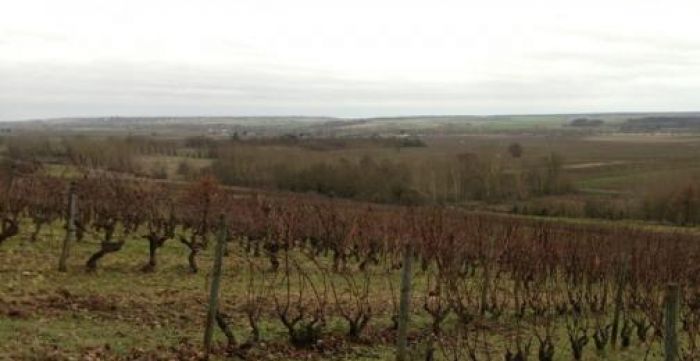
harvest report
15.09.2010
2010 Harvest Report from Matthieu Baudry
<p>It’s two weeks before we start picking.<br />
<br />
2010 has been without climatic excesses, with well-marked seasons, just like 2009. The winter was long and cold, ideal to let the vines have a “quiet sleep.” The <glossary term="Budding" title="1166">budburst</glossary> came a bit late but under good conditions, and there was a spring <glossary term="Frost" title="1135">frost</glossary> mid-May that did not do too much damage. Spring was pleasant, but too dry: only 4.5mm of rain in April and 17mm in May!<br />
<br />
<glossary title="1179">Flowering</glossary> started on June 5th, and we had rains of and on for two weeks, which cause <span class="zalup"><span><glossary term="Coulure" title="1252">coulure</glossary><span>,</span></span></span> so the <glossary title="1138">bunches</glossary> are many, but not too dense. Then it was very dry for a whole month, and there was no disease. Our number one foe,<span class="zalup"><span> <glossary title="1137">mildew</glossary><span>,</span></span></span> was not a problem. We did only four <glossary title="328">treatments</glossary> in the valley and three on the slopes.<br />
<br />
The first summer rains came around July 14th, and were welcome in the sandy <glossary title="1133">plots</glossary> that were suffering from the <span class="zalup"><span><glossary term="Drought" title="1167">drought</glossary><span>.</span></span></span> This was followed by another very dry month until August 28th, when it rained 28mm. More recently, on Sept. 7th, we got a big storm, but only 26mm of rain and no damage.<br />
<br />
So, even if we missed the rain this year, we are hoping for another dry spell until mid-October to <glossary title="521">harvest</glossary> under perfect conditions. The entire western part of France <span class="zalup"><span>(<glossary title="697">Muscadet</glossary><span>,</span></span></span> <span class="zalup"><span><glossary title="105">Anjou</glossary><span>,</span></span></span> <glossary title="919">Saumur</glossary> and western <glossary title="1036">Touraine</glossary>) had a dry growing season, the <glossary title="1129">yields</glossary> look to be adequate, slightly lower than in 2009 but still abundant enough. We think we’ll start on Oct. 4th. Everything is in place for a great <span class="zalup"><span><glossary title="1109">vintage</glossary><span>,</span></span></span> the grapes are evenly ripe and really healthy. Some people expect an even better <glossary title="1109">vintage</glossary> than 2009. We stay “zen” and, “like St. Thomas, we believe only what we can see.”</p>
Article
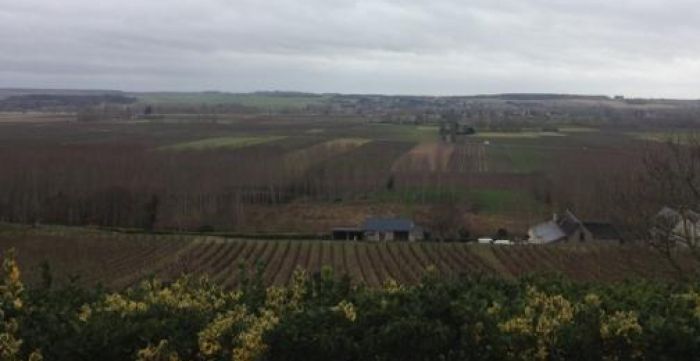
harvest report
07.11.2007
2007 Harvest Report from Matthieu Baudry
<p>April: sumptuous. Summer: rainy. September: happy winemaker: overwhelmed. Winemaker: demoralized. Winemaker: reassured.<br />
<br />
2007 could be summed up as a serialized story with multiple cliff hangers. Keep in mind that this is the year we decided to <glossary term="Conversion" title="332">convert</glossary> all our vineyards to <glossary term="Organic" title="746">organic</glossary> <span class="zalup"><span><glossary term="Viticulture" title="1103">viticulture</glossary><span>,</span></span></span> with an ambitious plan of using herbal treatments and of banning <glossary term="Chemicals" title="279">chemical products</glossary> altogether.<br />
<br />
The winter was mild, without <span class="zalup"><span><glossary term="Frost" title="1135">frost</glossary><span>.</span></span></span> March and April were superb, with hot temperatures, dry weather and wines which started to <glossary term="Budding" title="1166">bud</glossary> three weeks ahead of schedule. Never seen that before…. <glossary term="Flowering" title="1179">Blossoming</glossary> started in the middle of May instead of during the first week of June, which is the normal time. At that point we were experiencing a best of all worlds kind of feeling.<br />
<br />
Then May turned rainy and we had to do <glossary term="Contact Treatment" title="328">treatments</glossary> at a hellish rate. From May 15th till the end of August, it rained every single week, and we had to be in the vines on our tractors at the same pace to contain the dreaded <span class="zalup"><span><glossary term="Mildew" title="1137">mildew</glossary><span>.</span></span></span> The first symptoms of the disease became visible in June and got worse in July. Despite our best and quickest efforts, many grapes got contaminated on our wettest terrains.<br />
<br />
At that point, our morale was at its lowest. Our tractor drivers were exhausted, and by the middle of August, we had lost half our crop in Les Granges and in the most humid plots in the valley.<br />
<br />
To bio or not to bio? (NT: this pun is lost in translation, bio being short for biologique, the French word for <glossary term="Organic" title="746">organic</glossary>).</p>
<p>Maybe that’s not the question, since the vines of many colleagues using <span class="zalup"><span><glossary term="Conventional Farming" title="331">conventional</glossary><span>,</span></span></span> <span class="zalup"><span><glossary term="Chemicals" title="279">chemical treatments</glossary></span></span> also suffered from <span class="zalup"><span> <glossary term="Mildew" title="1137">mildew</glossary><span>.</span></span></span> We are sure that the vines environment (humidity and soil type, vigorousness of the plants) played an important part in the severity of the disease. Our “all <glossary term="Chemicals" title="279">chemical</glossary>” neighbors were sometimes able to keep “clean” and “ <span class="zalup"><span><glossary term="Mildew" title="1137">mildew</glossary><span>-</span></span></span>free” vines, but it had to be to the detriment of the grapes, which were bombarded with anti<span class="zalup"><span><span>-</span><glossary term="Mildew" title="1137">mildew</glossary> </span></span> and anti<span class="zalup"><span><span>-</span><glossary term="Botrytis/Noble Rot" title="181">botrytis</glossary> </span></span> products.<br />
<br />
We had to wait till the end of August for the rain to stop and for everybody to get a rest. We were quite pessimistic on the grapes capacity to ripen: from three weeks ahead, the crop seemed back to a normal early October start.<br />
<br />
Then came the celebrated month of September, unsung hero of some “badly started” <span class="zalup"><span><glossary term="Vintage" title="1109">vintages</glossary><span>,</span></span></span> like 1997 or 2002. The wind turned to northeast and dried out the soils and the vines. The sun appeared and a slight wave of optimism took over. Even Bernard, anxious and disgusted, started to believe that nothing was lost.<br />
<br />
Thanks to this superb September, we began our <glossary term="Harvest" title="521">harvest</glossary> on Sept. 26th, with a team of 45 pickers ready to cut and to<span class="zalup"><span> <glossary term="Sorting" title="1380">sort</glossary><span>.</span></span></span> Even more than in previous years, we were extremely vigilant on <glossary term="Sorting" title="1380">sorting</glossary> and keeping only ripe grapes with no dried out, rotten or unripe bunches. We also had three sorters at the entrance to the cellar, working on the conveyor belt before the grapes got into<span class="zalup"><span> <glossary term="Vat/Tank" title="1140">vats</glossary><span>.</span></span></span><br />
<br />
First, we noticed the low <glossary term="Yield" title="1129">yield</glossary> of 35<glossary term="hl/ha" title="528">hl/ha</glossary><span class="zalup"><span><span>,</span></span></span> due to <glossary term="Mildew" title="1137">mildew</glossary> and <span class="zalup"><span><glossary term="Sorting" title="1380">sorting</glossary><span>.</span></span></span> Second, we were astonished by the levels of sugar in the grapes, from 11.7 to 13.3% of <span class="zalup"><span><glossary term="alcoholic potential" title="1381">potential alcohol</glossary><span>,</span></span></span> despite the problems of the <span class="zalup"><span><glossary term="Vintage" title="1109">vintage</glossary><span>.</span></span></span> Third, we tasted juice that was fresh and pure. There isn’t the kind of <glossary term="Concentration" title="324">concentration</glossary> we got in 2004 and 2005, but the young wines are clean and elegant.<br />
<br />
Now, the <glossary term="Alcoholic Fermentation" title="87">alcoholic fermentation</glossary> is done and the <glossary term="Malolactic Fermentation" title="622">malolactic</glossary> has started. We taste the wines almost every day, and we are happy with them. The young Japanese <glossary term="Sommelier" title="969">sommelier</glossary> student who was with us throughout the <glossary term="Harvest" title="521">harvest</glossary> and <glossary term="Vinification" title="1104">vinification</glossary> loves the style of our wines. Bernard himself has trouble hiding behind his moustache his satisfaction and his enthusiasm for the <span class="zalup"><span><glossary term="Vintage" title="1109">vintage</glossary><span>.</span></span></span><br />
<br />
I must say that this style of fresh, pure wines is exactly to our taste. We must remain cautious, but it looks like 2007 is going to give wonderful surprises.</p>
Article

harvest report
16.09.2005
2005 Harvest Report from Matthieu Baudry
<p>“The Gods are with us!” 2005 looks like it may be an excellent <glossary term="Vintage" title="1109">vintage</glossary> even if we still have 10 days before the clippers go to work.<br />
<br />
As far as temperatures are concerned, 2005 is turning out to be similar to 1976 and even better than 1989 and 1990. Rainfall has been much lighter than the average for the past 40 years (almost identical to 1976, which was a <glossary term="Drought" title="1167">drought</glossary> year in France). There was slightly more than average sunshine but not enough to challenge the records of 1976, 1989 or 2003.<br />
<br />
So, 2005 has been a dry and consistently warm year. The <glossary term="Harvest" title="521">harvest</glossary> will be early (by about a week) and the <glossary term="Yield" title="1129">yields</glossary> will be on the small side. In contrast to 2003 with its record breaking temperatures, the grapes have concentrated more <glossary term="Acidity" title="71">acidity</glossary> and <glossary term="Phenols" title="784">polyphenols</glossary> (color and <glossary term="Tannin" title="1010">tannins</glossary>).<br />
<br />
2005 is a promising <glossary term="Vintage" title="1109">vintage</glossary> and will probably be of great quality. The grapes are fleshy and firm which leads me to think that we will get very well <glossary term="Structure" title="990">structured</glossary> wines which should age well.<br />
<br />
45 pickers are scheduled to start harvesting around September 28 and, weather permitting, we expect to finish around October 10.<br />
<br />
The <glossary term="Chenin Blanc" title="281">Chenin Blanc</glossary> grapes are superb and we are looking forward to the first <glossary term="Harvest" title="521">harvest</glossary> of a plot of <glossary term="Young Vines" title="1130">young vines</glossary> situated on a well <glossary term="Exposition" title="430">exposed</glossary> <span class="zalup"><span><glossary term="Clay" title="301">clay</glossary><span>-</span></span></span><glossary term="Limestone" title="596">limestone</glossary> slope.</p>
Article
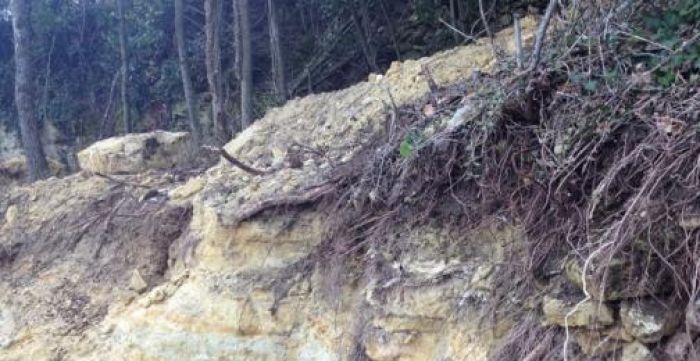
harvest report
20.10.2004
2004 Harvest Report from Matthieu Baudry
<p>Please forgive me for not writing my report earlier. I’ll try to catch up and will copy: “I must turn in my homework on time” a hundred times. Apparently, the <glossary title="310">carbon dioxide</glossary> from the <glossary title="441">fermentations</glossary> is not good for my brain. But everything is well.<br />
<br />
No <span class="zalup"><span><glossary title="1135">frost</glossary><span>,</span></span></span> no <span class="zalup"><span><glossary title="1136">hail</glossary><span>,</span></span></span> and weather conditions a lot less extreme than last year. Nevertheless, in 2004 the weather was very irregular: beautiful, warm and dry weather in June and July (actually drier than in 2003), followed by a very humid August, with persistant rains and overcast skies. September was warm, hot even in the beginning. October was variable (half fig/half grape, a French phrase describing a mixed bag), sunny at first, then a lot of rain after the 9th.<br />
<br />
We started our <glossary title="521">harvest</glossary> on October 4th and finished on the 14th. The first week was perfect, the grapes were firm and the ripeness sometimes better than in 2003. During the second week we had some annoying showers that prevented more <glossary term="Concentration" title="324">concentration</glossary> but maybe helped curb the <glossary title="71">acidity</glossary> and <glossary title="1010">tannin</glossary> levels.<br />
<br />
We are not complaining, because after the 11th the rain continued, it <glossary title="1136">hailed</glossary> and the sun could not take over. I don’t know yet what the style of the <glossary title="1109">vintage</glossary> is going to be. <glossary term="alcoholic potential" title="1381">Potential degrees</glossary> are high on the whole, often higher than in 2003! Colors are more intense than last year, thanks to a healthier level of <span class="zalup"><span><glossary title="71">acidity</glossary><span>.</span></span></span> We won’t have the quasi-southern character of 2003, the wines are fresher, with more <span class="zalup"><span><glossary title="990">structure</glossary><span>.</span></span></span><br />
<br />
We have made some nice tasting <glossary term="Rosé/Rosato" title="871">rosé</glossary> by <glossary title="392">direct pressing</glossary> chosen <glossary title="1133">plots</glossary> where the grapes were very ripe.<br />
<br />
<glossary title="1129">Yields</glossary> are higher than in 2002 and 2003, but not astronomical, comparable to 1999 or 2000.<br />
<br />
<glossary title="441">Fermentations</glossary> are going well and we will start removing the must from the <glossary title="441">fermentation</glossary> <glossary title="1140">vats</glossary> and <glossary title="827">press</glossary> in a week.</p>
Article

harvest report
10.09.2003
2003 Harvest Report from Bernard Baudry
<p>It is now five days before when we plan to start <glossary title="521">harvesting</glossary> the reds. Today is the official starting day for <span class="zalup"><span><glossary title="288">Chinon</glossary><span>.</span></span></span> We are in no hurry and would like to let our grapes take advantage of the good weather that is being predicted for the next few days. This summer’s heat has led to a <glossary title="521">harvest</glossary> that will start two weeks earlier than we do in more “conventional” years.<br />
<br />
I think that we have suffered a lot less from <glossary title="1167">drought</glossary> than many other regions in France which are three or even four weeks earlier than usual. This past weekend we had 60 mm of rainfall which is really quite a lot. As of today, the total rainfall since July 1st is 180mm: that’s a lot.<br />
<br />
Our situation is completely different than what one is seeing in the more Eastern regions of France.</p>
<p>The grapes are doing well. The skins have stayed firm and we have not observed any burning. The <glossary term="Young Vines" title="1130">young vines</glossary> have suffered a little, but it’s nothing catastrophic.<br />
<br />
We still have no idea about the quality of this<span class="zalup"><span> <glossary title="1109">vintage</glossary><span>.</span></span></span> The <glossary title="71">acidity</glossary> levels seem to be on the weak side but we’re not going to get fixated on that. The <glossary title="1129">yields</glossary> won’t be as bad as we originally thought but nevertheless, there is not much juice in these grapes.<br />
<br />
Early <glossary title="1109">vintages</glossary> are almost always good<span class="zalup"><span> <glossary title="1109">vintages</glossary><span>.</span></span></span> We are keeping our fingers crossed.</p>
Article























